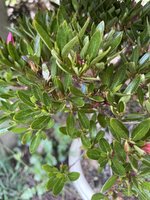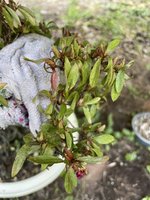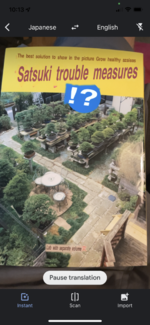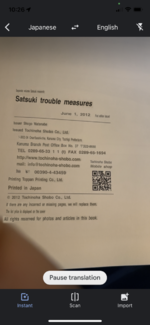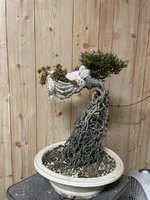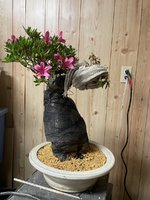Further thinking about this issue…. and viewing your image from last year.
There isn’t a lot of negari satsuki restoration literature. Actually haven’t seen one reference to this in all my research through the entire PB Museum library of azalea information.
Looking at the tree, it’s actually an issue of an aging satsuki. Plus some root issues. Together things are accelerating towards decay. Yet it seems restoration is possible to me.
Dying of the apex is common once an azalea’s branches reaches a certain age. That’s because the sap pathways in the branches eventually get smaller and smaller over time…and the apex on a nasally dominant tree takes the hit first.
Unless the branches are revitalized by regrowing them over time, with young sap pathways the entire tree will weaken over time. This can be forestalled by sharp cutting back every third year and also by trimming properly to get light inside the canopy to allow back budding toward the trunk. The situation gets worse if the tree is allowed to bloom every year.
[As an aside. PW is a bit of an outlier in saying the tree would be ok to bloom every year, as
@Glaucus mentioned. (As a professional I’m not sure PW ever really meant to allow trees to bloom fully each year, because it’s not done.) Recognize even show azaleas aren’t allowed to fully bloom in show years. The strong and weak buds are excised and others to keep the bloom spacing from being overcrowded, spoiling the display. so the tree will never bloom fully each year. At least a 1/3 or more one th buds are excised before the bloom. Standard dogma is to not allow blooming every third year for the tree to regain strength (from blooming 2/3 or less!).]
Yet eventually all branches have to be replaced. Your photo last year was a sign that the basal branches needed to be cut back hard to help divert energy to the apex. Waiting allowed the resources to continue being directed basally. Not your fault, you didn’t know. It is a very impressive and likely one time expensive tree. You merely thought a new apex needed to be grown.
Once I saw the photo all the pieces clicked in. We have a number of azaleas at the museum tha5 we work on and some are in the same situation…. Here’s an example of an R. Kiusianum with the same issue. You can see the apex is weak… it bloomed late and less then normal each year until this last fall it was in restoration status. This was timely. Last fall the basal branches were reduced by a third. This year flowering is kept minimal, the basal branches are being pushed back further and new growth is appearing at the apex and near the middle pad and is allowed to grow at will. Our restoration will take est. 5-8 years at this time… hopefully less.

So here’s what I’m proposing.
Cut off most if not all of the flower buds.…. push back all the lower branch growth soonest.
Allow new growth to sprout unchecked, especially off the trunk where new upper branches/apex can be formed.
Encourage growth off the lower trunk in areas that could be new lower branches.
Also investigate the media. Root issues in Kanuma only or Kanuma with minor amounts of pumice are virtually unknown with proper care. Its awful hard to overwater a Kanuma only media. Bark, turface etc only complicate the media. Chopped Sphagnum moss is only if you need additional moisture retention and if you trace any roots in poor condition Sphagnum can be used to wrap these. This may mean carefully replacing some of the media this year,
So I’ll toss in an out of the box idea that will definately help boost the roots and top hamper health. Take it or leave it. Some folks would rather tough it out with what they have. It will definately get the tree healthier faster. Yet your tree, your choice
Fashion a plastic collar over the negari… you choose whether it to take it all the way up to the top. Any amount from a 1/3 on up should help. Fill the negari with medium Kanuma… and water as normal. This will make the existing roots healthy and sprout new roots off of them, feeding the green growth. After two growing seasons you can slowly lower the “collar”, picking out the Kanuma and any Sphagnum.
Like I said, your tree, your choice. Thanks for hearing me out.
cheers
DSD sends

